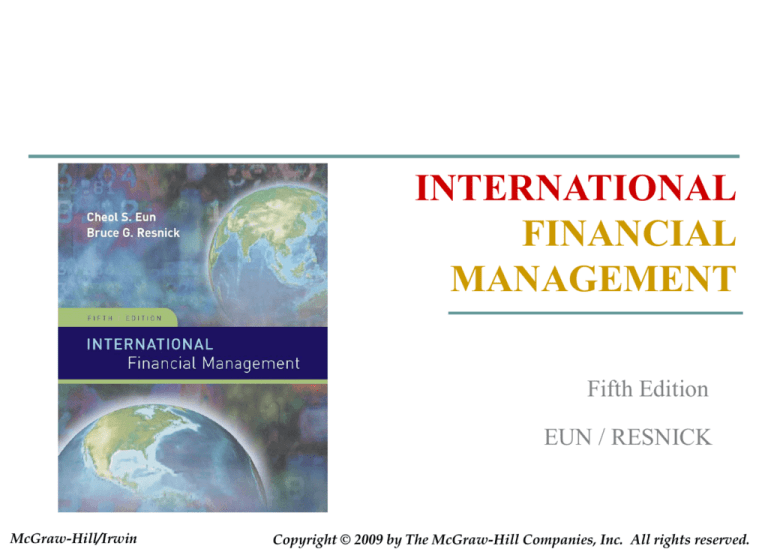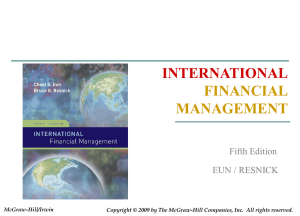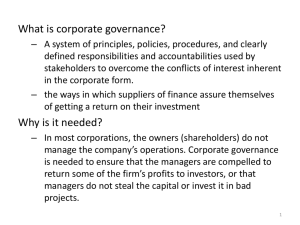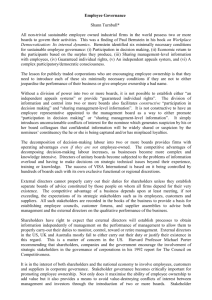
INTERNATIONAL
FINANCIAL
MANAGEMENT
Fifth Edition
EUN / RESNICK
McGraw-Hill/Irwin
Copyright © 2009 by The McGraw-Hill Companies, Inc. All rights reserved.
Corporate Governance
Around the World
4
Chapter Four
Chapter Objective:
This chapter discusses corporate governance
structures, which varies a great deal across
countries, reflecting divergent cultural, economic,
political, and legal environments.
4-1
Chapter Outline
4-2
Governance and the Public Corporation: Key
Issues
The Agency Problem
Remedies for the Agency Problem
Law and Corporate Governance
Consequences of Law
Corporate Governance Reform
Governance and the Public Corporation:
Key Issues
4-3
The public corporation, which is jointly owned by
a multitude of shareholders protected with limited
liability, is a major organizational innovation of
vast economic consequences.
It is an efficient risk sharing mechanism that
allows corporations to raise large amounts of
capital.
Governance and the Public Corporation:
Key Issues
4-4
A key weakness is the conflict of interest between
managers and shareholders.
In principle, shareholders elect a board of
directors, who in turn hire and fire the managers
who actually run the company.
In reality, management-friendly insiders often
dominate the board of directors, with relatively
few outside directors who can independently
monitor the management.
Governance and the Public Corporation:
Key Issues
In the case of Enron and other dysfunctional
corporations, the boards of directors grossly failed
to safeguard shareholder interests.
Furthermore, with diffused ownership, most
shareholders have strong enough incentive to
incur the costs of monitoring management
themselves.
4-5
It’s easier to just sell your shares a.k.a. “The Wall Street
Walk”.
The Agency Problem
4-6
Shareholders allocate decision-making authority to
the managers.
That’s why the managers are hired in the first place.
Many shareholders are not qualified to make
complex business decisions.
A shareholder with a diversified portfolio would not
have the time to devote to making the numerous
decisions at each of his many companies anyway.
The Agency Problem
Having the short-term control of the firm’s assets,
managers might be tempted to act in the
manager’s short-term best interest instead of the
shareholder’s long-term best interest.
Consumption of lavish perquisites is one example.
Outright stealing is another example.
4-7
Some Russian oil companies are known to sell oil to managerowned trading companies at below market prices.
Even at that, they don’t always bother to collect the bills!
The Agency Problem at Enron
Enron had about 3,500 subsidiaries and affiliates
Many of these were run and partly owned by Enron
executives.
In retrospect, conflict of interest should have been an
obvious concern.
4-8
The partnerships did hundreds of millions of dollars of
transactions with Enron itself, in some cases buying assets
from the company or selling assets to it.
The problem is this: Where did the executives' loyalties
lie? Are they trying to negotiate the best deal for the
company that employs them and the shareholders who own
the company, or the best deal for the partnership where
they had an ownership stake?
The Agency Problem at Enron
4-9
The board of directors claimed that these
partnerships with executive ownership allowed
the firm to speed up contracting.
To protect itself in dealings with these
partnerships, the company says that it set up
safeguards that required top company officers and
the board to review and approve deals between
Enron and the partnerships.
Clearly these safeguards were insufficient.
Remedies for the Agency Problem
4-10
In the U.S., shareholders have the right to elect
the board of directors.
If the board remains independent of management,
it can serve as an effective mechanism for curbing
the agency problem.
Corporate Boards
The structure and legal charge of corporate boards
vary greatly across counties.
4-11
In Germany the board is not legally charged with
representing the interests of shareholders, but is rather
charged with representing the interests of stakeholders
(e.g. workers, creditors, etc.) as well as shareholders.
Corporate Boards
The structure and legal charge of corporate boards
vary greatly across counties.
4-12
In England, the majority of public companies
voluntarily abide by the Code of Best Practice on
corporate governance.
It recommends there should be at least three outside
directors and the board chairman and the CEO should be
different individuals.
Corporate Boards
The structure and legal charge of corporate boards
vary greatly across counties.
4-13
In Japan, most corporate boards are insider-dominated
and primarily concerned with the welfare of the keiretsu
to which the company belongs.
Incentive Contracts
It is difficult to design a compensation scheme
that gives executives an incentive to work hard at
increasing shareholder wealth.
Accounting-based schemes are subject to
manipulation.
4-14
Arthur Andersen’s involvement with the Enron debacle
is an egregious example.
Executive stock options are an increasingly
popular form of incentive compatible
compensation.
Executive Stock Options
Executive Stock Options exist to align the interests of
shareholders and managers.
Executive Stock Options are call options (technically
warrants) on the employer’s shares.
4-15
Inalienable: the option can’t be sold.
Typical maturity is 10 years.
Typical vesting period is 3 years.
Executive Stock Options give executives an important tax
break: grants of at-the-money options are not considered
taxable income. (Taxes are due if the option is exercised.)
Valuing Executive Compensation
FASB allows firms to record zero expense for grants of atthe-money executive stock options.
However the economic value of a long-lived call option is
enormous, especially given the propensity of firms to reset
the exercise price after drops in the price of the stock.
Due to the inalienability, the options are worth less to the
executive than they cost the company.
4-16
The executive can only exercise, not sell his options. Thus he
can never capture the speculative value—only the intrinsic
value.
This “dead weight loss” is overcome by the incentive
compatibility for the grantor.
Concentrated Ownership
4-17
Another way to alleviate the agency problem is to
concentrate shareholdings.
In the United States and the United Kingdom,
concentrated ownership is relatively rare.
Elsewhere in the world, however, concentrated
ownership is the norm.
Pyramidal Ownership Structure
4-18
Exhibit 4.6 illustrates the pyramidal ownership
structure for Daimler-Benz, a German company,
at the beginning of the 1990s.
The company has three major block holders:
Deutsche Bank (28.3 percent), MercedesAutomobil Holding AG (25.23 percent), and the
Kuwait government (14 percent). The remaining
32.37 percent of shares are widely held.
Pyramidal Ownership Structure
The pyramidal ownership structure illustrated in
Exhibit 4.6 makes it possible for large investors to
acquire significant control rights with relatively
small investments.
4-19
For example, Robert Bosch GmbH controls 25 percent
of Stella Automobil, which in turn owns 25 percent of
Mercedes-Automobil Holding, which controls 25
percent of Daimler-Benz
AG. Robert Bosch can possibly control up to 25 percent
of the voting rights of Daimler-Benz AG with only 1.56
percent cash flow rights in the company.
Daimler-Benz
AG
Exhibit 4.6
28.3%
Deutsche
Bank
14%
Kuwait
government
25%
Widely Held
25%
Stella Automobil
Beteiligungsges
mbH
25%
Bayerische
Robert Bosch
Landesbank
GmbH
4-20
25.23%
MercedesAutomobil
Holding AG
25%
Stern Automobil
Beteiligungsges
mbH
25%
Kornet Automobil
Beteiligungsges
mbH
32.37%
Widely Held
50%
Widely Held
25%
Dresdner
Bank
Pyramidal Ownership Structure
4-21
AG. Robert Bosch can control up to 25 percent of
the voting rights of Daimler-Benz AG with only
securing the cooperation of 3 other firms:
At least two of these three: Bayerische
Landesbank, Kornet Automobil Beteiligungsges
mbH, or Dresdner Bank.
And Stern Automobil Beteiligungsges mbH.
Not bad for only directly controlling 1.56% of the
company.
Debt
4-22
If managers fail to pay interest and principal to
creditors, the company can be forced into
bankruptcy and managers may lose their jobs.
Borrowing can have a major disciplinary effect on
managers, motivating them to curb private
perquisites and wasteful investments and trim
bloated organizations.
Excessive debt creates its own agency problems,
however.
Overseas Stock Listing
4-23
Companies domiciled in countries with weak
investor protection can bond themselves credibly
to better investor protection by listing their stocks
in countries with strong investor protection.
The Market for Corporate Control
4-24
If a management team is really out-of-control,
over time the share price will decline.
At some point, a corporate raider will buy up
enough shares to gain control of the board.
Then the raider either fires the feckless managers
and turns the firm around or he sells everything in
sight for the break-up value.
Either way, the old managers are out of a job.
The threat of this unemployment may keep them
in line.
Law and Corporate Governance
Commercial legal systems of most countries
derive from a relatively few legal origins.
4-25
English common law
French civil law
German civil law
Scandinavian civil law
Thus the content of law protecting investors’
rights varies a great deal across countries.
It should also be noted that the quality of law
enforcement varies a great deal across countries.
Consequences of Law
Protection of investors’ rights has major economic
consequences.
These consequences include
4-26
The pattern of corporate ownership and valuation.
Development of capital markets.
Economic growth.
Consequences of Law: Italy vs. U.K.
Italy has a French civil law tradition with weak
shareholder protection, whereas the United
Kingdom, with its English common law tradition,
provides strong investor protection.
In Italy (U.K.), the three largest shareholders own
58 percent (19 percent) of the company, on
average.
4-27
Company ownership is thus highly concentrated in Italy
and more diffuse in the United Kingdom.
Consequences of Law: Italy vs. U.K.
4-28
In addition, as of 1999, only 247 companies are
listed on the stock exchange in Italy, whereas
2,292 companies are listed in the United
Kingdom.
In the same year, the stock market capitalization
as a proportion of the annual GDP was 71 percent
in Italy but 248 percent in the United Kingdom.
The stark contrast between the two countries
suggests that protection of investors has
significant economic consequences.
Ownership and Control
4-29
Companies domiciled in countries with weak
investor protection many need to have
concentrated ownership as a substitute for legal
protection.
This is not without costs, with concentrated
ownership, large shareholders can abuse smaller
shareholders.
Capital Markets and Valuation
4-30
Investor protection promotes the development of
external capital markets.
When investors are assured of receiving fair
returns on their funds, they will be willing to pay
more for securities.
Thus strong investor protection will be conducive
to large capital markets.
Weak investor protection can be a factor in sharp
market declines during a financial crisis.
Economic Growth
The existence of well-developed financial markets,
promoted by strong investor protection, may stimulate
economic growth by making funds readily available for
investment at low cost.
Several studies document this link.
Financial development can contribute to economic growth
in three ways:
4-31
It enhances savings.
It channels savings toward real investments in productive
capacities.
It enhances the efficiency of investment allocation.
Corporate Governance Reform
4-32
Scandal-weary investors around the world are demanding
corporate governance reform.
It’s not just the companies’ internal governance
mechanisms that failed; auditors, regulators, banks, and
institutional investors also failed in their respective roles.
Failure to reform corporate governance will damage
investor confidence, stunt the development of capital
markets, raise the cost of capital, distort capital allocation,
and even shake confidence in the capitalist system itself.
The Sarbanes-Oxley Act
Major components:
4-33
Accounting regulation
Audit committee
Internal control assessment
Executive responsibility
Many companies find compliance onerous,
costing millions of dollars.
Some foreign firms have chosen to list their
shares on the London Stock Exchange instead of
U.S. exchanges to avoid costly compliance.
CFA Institute Ethical and Professional
Standards of Corporate Governance
Quality of Corporate Governance
• The Board:
Are they cozy with Mgt?
– Is it largely independent?
– Are the directors qualified?
– Do they have access to outside resources?
– How are they elected?
– Do any directors have cross-company relationships?
• Management: Are they vendors or customers?
– Do they have a code of ethics?
– Are there lots of perquisites?
– How is their compensation structured?
4-34
Key Board Committees
• Audit Committee:
– Oversees financial reporting.
Should watch out for Accounting shenanigans
• Executive Compensation Committee:
– Approves compensation packages including bonuses,
stock options, severance, loans, etc.
What incentives are being created?
• Nominations Committee:
– Recruits and proposes new board members.
Are they “stacking” the board?
4-35
End Chapter Four
4-36









